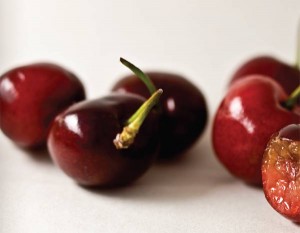
Late spring marks the start of stone fruit season. (So-called because these fruits contain a single pit, or “stone.”) First come cherries and then apricots, followed by peaches, nectarines, plums, and all their various hybrids. Unlike the tasteless, mealy imports found in supermarkets, your farmers’ market carries tree-ripened, locally grown fruit—just the way nature intended. One juicy bite and you’ll be hooked. I promise.
Cherry season starts off slowly with the arrival of the Black Tartarian and Burlat; followed by the blushing yellow Royal Anne and Rainier. Sour cherries, like the Montmorency or Morello are primarily grown outside of California, and valued mostly for pies, jam, and for drying. Most agree the West’s dark, sweet, meaty Bing is the quintessential cherry, followed closely by Lamberts and Vans.
Long before it was known as a search engine, Bing was just a cherry. (And, of course, a famous crooner.) A cross between the Tartarian and Royal Anne, the Bing was developed in Oregon in 1875 by Seth Lewalling. Legend has it that because he didn’t have enough money to pay his Chinese cook’s wages, he named the new cherry after him.
Here are some helpful cherry factoids:
- Cherries should be shiny, plump, and firm.
- A green stem is an indicator of a just-picked cherry.
- Refrigerate cherries, unwashed, in an open plastic bag. It’s best to eat them within several days of purchase.
- Cherries-on-the-stem tend to last longer.
- Cherries contain vitamin C, and about 87 calories per cup.
- Cherry juice can stain your hands, so you may want to wear latex gloves—and an apron—while pitting them.
- A cherry-pitter is an inexpensive kitchen tool that makes the job a breeze. (It works a bit like a paper punch, forcing the pit out of the cherry.) Lacking one, just use the tip of a small, sharp knife.
Though not much can beat a cherry eaten out of hand, it’s fun to use them in unexpected ways. Act quickly, though, for cherry season is short but sweet…about 3 1/2 weeks, to be exact.
Spice things up: Transform pitted cherries into a zesty salsa by adding finely chopped red or green onion; minced jalapeño chile pepper; finely grated fresh ginger; coarsely chopped cilantro or mint; a tiny drizzle of olive oil, a pinch of salt; and fresh lemon or lime juice, to taste. Serve alongside pork or poultry; with a gooey jack cheese quesadilla; or for dipping tortilla chips.
Sweeten things up: Jazz up your favorite upside-down cake, substituting pitted fresh cherry and apricot halves for the usual canned fruit.
To preserve stemmed pitted cherries for baking year ‘round, flash-freeze them on a baking sheet until firm; then pack into freezer-safe bags or plastic containers. Use frozen.
Late Spring Fruit Salad: In a bowl, toss together stemmed, pitted, and halved cherries; cubes of ripe cantaloupe; pitted apricot halves (or quarters, if large); a pinch of salt; a splash of sweet white wine; and a few fresh mint leaves, cut into thin strips.
Salad Days: Grill a well-seasoned skirt or flank steak until nicely charred on the outside and pink in the middle. While the meat rests on a cutting board, make a mustardy balsamic vinaigrette. In a bowl, combine young arugula leaves and stemmed, pitted, and halved cherries; drizzle with just enough vinaigrette to coat lightly, and toss gently to mix. Spread the salad over a large platter. Cut the beef across the grain into thin slices and arrange on top of the salad. Top with crumbled blue or goat cheese, and a few toasted almonds. Serve with warm crusty bread.
Gilding the Lily: Add fresh cherries to your favorite chicken salad or rice pudding; layer them in trifles, or bake the classic French clafoutis. Pile fresh cherries on a cheese platter; or build an adult-ice cream sundae by first macerating cherries in kirsch, brandy, or amaretto. (Heat the fruit topping, and you’ve got Cherries Jubilee.) Or mix them into slightly-softened vanilla ice cream, with or without shards of semisweet chocolate, for a home-style take on one of the country’s favorite ice cream flavors.
For an elegant ending to a meal, rinse perfect ripe cherries and pat them dry. Working one at a time and holding each by the stem, dip the cherries in melted dark or white chocolate and transfer to a parchment-lined baking sheet; then refrigerate until the chocolate coating is firm. (This is an especially charming presentation for “twins”—2 cherries joined at the stem.) Just be sure to warn your guests these cherry-chocolate bonbons contain pits.)
Savoring the Moment: Forget those scary iridescent cherries sold in jars and make your own boozy ones to garnish cocktails or desserts. For each pint jar you’ll need about 1 pound of fresh cherries. Rinse them well and pat dry; pit them or not, as you like. (If you don’t pit them, prick each cherry 2 or 3 times so the liquor will penetrate the fruit.) Pack cherries into a sterilized jar, cover with bourbon, rye, brandy, kirsch, or Maraschino liqueur, and refrigerate. When all the cherries have been eaten, mix the remaining alcohol in cocktails.
The Danville Certified Farmers’ Market, located at Railroad and Prospect, is open every Saturday, rain or shine, from 9 a.m. until 1 p.m. For specific crop information call the Pacific Coast Farmers’ Market Association at 1-800-949-FARM or visit their web site at www.pcfma.com.
Leave a Reply